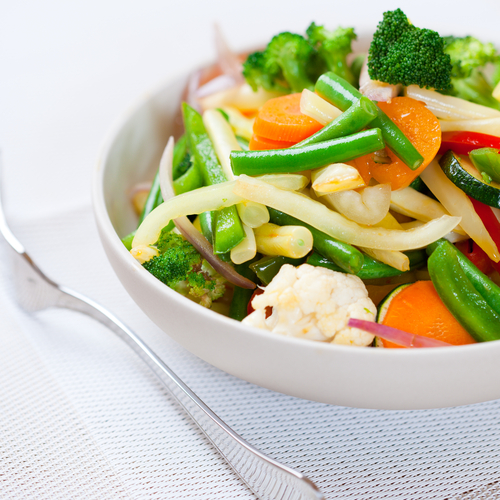The problem with diets, and why they don’t work in the long run, is that that focus on what you can’t eat. For instance, vegetarians must say no to chicken wings, and vegans, no eggs or animal products at all.
Most people would be successful in losing weight and keeping it off if, instead of a super-restrictive diet, they could have a bit of leeway in what they ate. This is why the flexitarian diet has become so popular.
Often described as vegetarians with benefits, flexitarians are those whose diet consists mostly of fruits, vegetables, legumes and grains, with the occasional meat, fish or poultry. While “true” vegans and vegetarians consider flexitarians heretics and their lifestyle “cheating,” the diet may just be one of the best ways to improve overall health while reducing environmental impact.
What’s It All About?
By now you’ve probably noticed the word “flex,” which is short for flexible. Instead of committing to a plant-based diet full-time, flexitarians primarily focus on eating whole foods like fruits, vegetables, grains and dairy. As for the amount of meat consumed, it will vary with each individual. Some may spend most of the week meat-free but enjoy a Sunday ham with family. Others may eat a small portion of meat several days a week.
As you can see, the flexitarian doesn’t cut meat out of the diet, but treats it more as a side dish than the main dish. This may seem odd to many people who grew up in an age of “meat & potato” mentality, but Americans are eating far more meat than we used to. For instance, in the 1950s, the average American adult consumed 138.2 pounds of meat a year. Consider the fact that in the year 2000, Americans were, on average, eating 195 pounds per year.
For health reasons, cutting back on meat consumption just makes sense, and for those who can’t begin to imagine life without burgers or fish tacos, flexitarianism offers the perfect compromise.
The Main Benefits of Flexitarianism
It’s Easy to Stick to
The biggest benefit of flexitarianism has to be the ability of most people to use it for long-term health. Because there are no hard and fast rules, people have an easier time sticking with it. The key to this is rethinking foods. Instead of thinking “no meat,” people simply need to focus on eating more fruits and veggies instead.
Another added bonus is that, by reducing meat intake, most households can afford to purchase grass-fed beef and wild-caught salmon, instead of the more affordable farmed meats and fish that are typically eaten 7 days a week. These inferior animal products cause inflammation in the body, which in turn leads to a host of diseases.
[Editor’s note: One of the “host of diseases” caused by inflammation is Joint Pain. The kind of joint pain that will build and fester, until it becomes an unwanted part of your life. But don’t suffer in silence – for every problem, there is a solution. This NATURAL discovery gives joint pain relief in just 7 days, by targeting the 3 major sources of inflammation… see for yourself!]
You’ll Reap the Nutritional Benefits of Animal Products
While there is no denying the health benefits of a plant-based diet, animal products also offer nutritional benefits. First, while plants do offer proteins, none can rival the proteins found in eggs, meat, and dairy. Getting enough quality protein in your diet is essential to grow and maintain muscle mass, stabilize blood sugar, and keeping bones strong and healthy.
In addition, eating wild-caught fish, one of the best sources of omega-3 fatty acids, means you’ll protect your heart, brain, while fighting diseases like cancer.
You’ll Reduce Your Environmental Impact
It’s super important that people understand one critical fact: eating less meat positively affects the environment. Compared to plants, livestock requires much more food, water, land and energy to grow and, later, transport.
NPR gave an example of what it takes to make just one quarter-pound hamburger:
- 7 pounds of grain and forage
- 8 gallons of water for drinking and irrigating feed crops
- 5 square feet for grazing and growing feed crops
- 1,036 BTUs of fossil fuel energy for feed production, enough to power the average microwave for 18 minutes.
Keep in mind, that’s just for one small burger.
Most Americans don’t realize that the food system is responsible for more than one quarter of all greenhouse gas emissions. The good news is, by adopting a flexitarian diet, you can do your part to help the environment.
How to Become a Flexitarian
If what you’ve read so far makes sense and you’d like to adopt the flexitarian lifestyle, here are some steps to get you started:
Step 1 – Eat More Plant-Based Foods
This is the obvious first step. With the flexitarian diet you don’t think less – you think more – as in eat more fruits and veggies. A quick and easy way to ensure you and your family are getting enough servings of plant-based foods is to use a blender like the NutriBullet to whip up delicious and healthy fruit and vegetable concoctions for breakfast and snacks.
Also, begin to swap out unhealthy side dishes and snacks for healthier fruits and veggies. Instead of that bag of chips in your son’s lunch, how about a baggy of carrot slices and hummus? Forgo the mac-n-cheese for roasted veggies instead.
Step 2 – Start Treating Meat Like a Condiment
Your goal is to stop thinking of meat as the star of the show and more of a condiment or side dish. Always make sure there are more vegetables on your plate than meat on those days you choose to eat it.
Step 3 – Buy the Good Stuff
As I mentioned previously, one of the great things about eating less meat is that you can afford to buy the good stuff for your family. Go for the wild-caught fish, grass-fed beef and free-range chicken. Staying away from the cheaper, processed meats will keep all of you healthier.
Step 4 – Don’t Overload on Carbs
The idea here is to replace meat with whole foods like fruits, veggies, legumes and grains. By eating less meat but more cheesy pasta or French fries, you’ll feel worse, not better. You’ll most likely also pack on the pounds as well. The Flexitarian diet, while more loosey-goosey in its “rules” does not mean you can be flexible and eat a bunch of processed garbage.
Step 5 – Make Sure You’re Getting Enough Essential Nutrients
Cutting back on animal products, while ultimately healthier, does mean you must make certain you’re getting the recommended daily values of certain nutrients, either through other foods or supplements.
Two important ones are:
Vitamin B12: Vitamin B12 is important in maintaining energy levels, supporting mood, and keeping your heart healthy. Supplementing with a foods-based B-complex supplement will ensure you keep your levels up.
Iron: Getting enough iron is critical as iron is what helps transport oxygen throughout the blood. It is especially important for women, who lose iron during their monthly menstrual cycles. Healthy iron levels prevent anemia and ensure the brain functions properly. Dark leafy veggies like spinach are an excellent source of iron.
Natural supplements can often be an effective solution to many health problems, but it’s best to buy these supplements from trusted sources – you have to look for the finest ingredients in the world, perfect formulations and high quality manufacturing. The good news is I’ve done all that work for you! From joint pain support to brain boosters to fresh omega-3… Click Here for the highest quality supplements that money can buy.
 Validating...
Validating... 






1 Comment